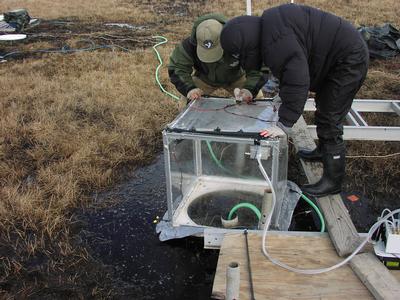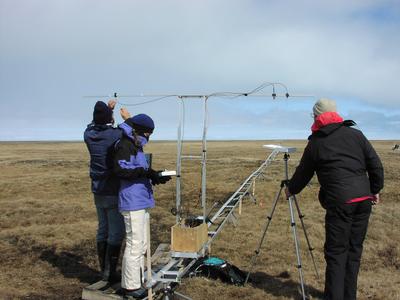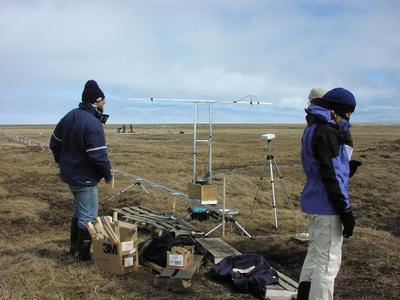18 June, 2001
Monday
Today we will be taking diurnal measurements, the first for all of us
except Glen who has been taking diurnals at his site for the last two
years. A diurnal is a 24-hour time period of continuous measurements.
There are 4 of us here now so Glen divided the time into four, 6-hour
shifts starting at 4PM this afternoon. Michelle- 4 to 10 pm, Spring- 10pm
to 4am, me- 4 to 10 am and Glen takes the last one, 10am to 4pm. The ITEX
(International Tundra Experiment) group from University of Michigan is also
doing a diurnal at the same time.
We hauled all the instruments, batteries and the cuvette out after lunch
and went over the possible things that could happen and then all practiced
with the LiCor (the portable photosynthesis system). What we will be doing
is covering each circular plot with the cuvette, making sure there is a
tight seal so no surrounding air can get in, turning on the LiCor and
having the chamber air pass through the instrument. The instrument
registers and records the amount of CO2 in the air sample. We do this 3xs.
The second step is to darken the cuvette totally (we have a light proof
cover) to simulate nighttime when respiration occurs and the plants give
off CO2. Once again we have the chamber air pass through the LiCor and it
measures CO2 in the air sample but this time we should see more CO2 being
recorded. The time consuming part of this is knowing when to log in
numbers. Because numbers appear on the readout panel does not mean they
are significant so until we become familiar with a range of expected
values we are hesitant. The difference between these two measurements, CO2
amounts from light and dark, is the flux, the measure we are looking for.
Every few hours the instrument has to be zeroed out also. This insures
that the LiCor has not drifted and taking measurements that are off.
If you remember the diagram of the site from 06/06 there are 3 sections
and each of those sections have 6 plots that are testing a different
variable: temperature (elevated or normal), soil moisture (high, low,
normal) and a control. Each plot has to have the LiCor measurements record
readings for light and dark three times, ideally. We each should make it
around the entire site 1 and 1/2xs.
At 4pm we left Michelle at the site so we could go back and catch a nap or
early bedtime. A radio is left so who ever is on site is in constant
contact with Glen plus the CMDL observation dome is open (and heated) if
one gets too cold. Being light 24 hours also makes being out for 6 hours
easier.
Glen, Spring and I returned to NARL, our home away from home, ate dinner
and caught up on sleep in preparation for our individual shifts.

Glen and Michelle are setting up for the diurnal which runs today from 4PM to tomorrow at 4PM. The wires on top of the cuvette run from the 12 volt battery to power the fans inside. To the bottom right is the LiCor which actually records the CO2 measurements.

The four of us looking over the LiCor before we stated our individual 6 hour shifts. Reminds me of.....How many scientists does it take to...??

The track is set up and ready to run! . John from Cal. State LA and Fred from University of Maryland, are using this to measure plant reflectance. Stan and Erika are working with them all summer and will be staying to collect data and troubleshoot any mechanical problems. (John is not pictured here.)

A shot of both Glen's project, where I am in background, and John and Fred' project in foreground. One gets a feel for the expanse of tundra and sky in this picture also.
Contact the TEA in the field at
.
If you cannot connect through your browser, copy the
TEA's e-mail address in the "To:" line of
your favorite e-mail package.
|
